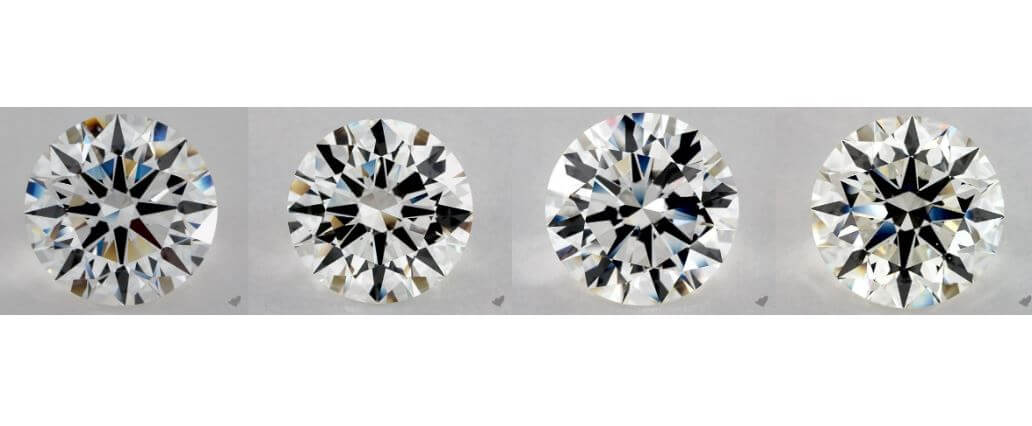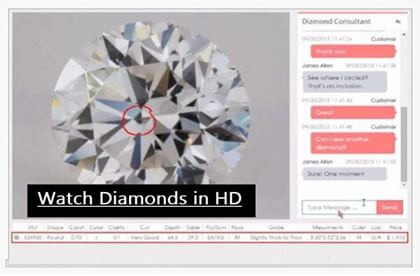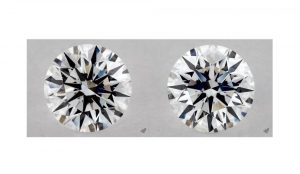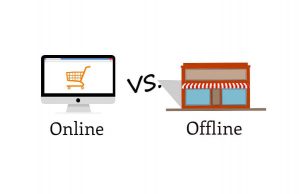Executive Summary
Diamond color is a very important part of the diamond 4Cs and forms one of the core for evaluating the quality and value of a diamond.
The diamond color grade scale invented by the GIA has 23 different grades of diamond color. These 23 diamond color grades are further divided into 5 different groups which are; colorless diamonds, near colorless diamonds, faint color diamonds, very light color diamonds and light color diamonds.
Colorless diamonds are D-F grades. They do not have any colors in them.
Near colorless diamonds are G-J grades. They have little amount of color in them. But it is very unnoticeable and appears colorless to the average person. Only trained gemologists can differentiate them.
Faint color diamonds are K-M. They have a yellow tint on them that is very visible to the eye and doesn’t require any expertise to discern.
Very light color diamonds are N-R. Brown or yellow color is very obvious in them. They are low in demand.
Light color diamonds are S-Z. They are in more demand than the group above them because they look like yellow stone and people consider them as replacement for faint yellow and light yellow.
The near colorless diamonds (G-J) are further divided into 2 groups. G-H and I-J. G-H diamonds appear more like the colorless diamonds above them while the I-J diamonds tends more towards the faint color diamond below them. If you look at the G-H diamonds with your eyes, you would find that it appears like a colorless diamond. These are the diamonds that gives you the value for your money. Buying the G and H diamonds would mean that you are buying a quality diamond at a cheap price without actually compromising on the quality of the diamond color. Very much like the colorless diamonds, the G and H diamonds are also very rare, taking up just about 2-3% of all diamonds. They offer very similarly to the colorless diamonds. They are colorless to the eye and come at a remarkably cheaper price than the colorless diamond. So you shouldn’t be spending much on colorless diamonds when no one would even notice the different between a grade D diamond and a grade H diamond just by looking at it.
The I and J diamonds on the other end has some yellow tint on them that may or not be noticed. But if you set I diamond on a yellow gold, it will appear whiter. As much as possible, try stay away from the J diamond.
Why Diamond Color is Important?
The 4Cs of diamond are the 4 major components used to determine the overall value of the diamond. They are cut, color, clarity, and carat weight. The diamond color is a very important part of the 4Cs as it affect the beauty and appearance of the diamond. After determining the quality of the diamond cut, the color of the diamond is the second most important thing to consider.
As important as the diamond color is, it is not something that you ought to overpay for. Color in diamond can range from colorless to yellow color. When buying a diamond, it is important to choose the best diamond color grade in relations to the diamond setting and the size of your budget. You just have to make sure that the diamond appears colorless no matter the color grade that you choose. To do this, you need a basic understanding of diamond color and diamond color grade scale.
Diamond Color
Diamond color is a measure of how clear (colorless) or how yellow (colorful) a diamond is. This is used to evaluate the quality and value of the diamond. The best diamonds and the diamonds of high quality and the most expensive diamonds (in relations to color) are those ones without color. On the other hands, diamonds with yellow tint are of lower quality and are cheaper.
The GIA scale is used to measure the degree of color or color grade of a diamond. The scale runs from D (colorless) to Z (light yellow or brown color). In between these two extremes, there are many other diamond color grades all classified into 5 different groups; colorless diamonds, near colorless diamonds, faint color diamonds, very light color diamonds, light color diamonds.
Diamond Color Grade Scale
The GIA color scale, the standard scale for grading the color of diamonds, was invented many years ago using the Latin alphabets. The scale runs from D-Z rather than from A because many other grading entities already had methodologies that made common use of the first 3 alphabets A, B and C. so the GIA decided to omit these 3 letters to avoid confusion.
There are 23 different diamond color grades classified into 5 different groups.
Colorless diamonds (D-F): This is the first group. It is the group of diamonds on the color scale considered as colorless diamonds. This is because they are truly colorless and do not have the yellow tint others have to various degrees. They are very rare and are therefore the most valuable and most expensive. Although all 3 members of the group are colorless, there is a difference in color between them that is impossible to notice except they are compared side by side by an expert gemologist. This difference between them leads to a difference in their prices and market value. Assuming that all other factors are the same, the price of these diamonds in the market could be $9,500, $8,250 and $7,500 respectively.
Since these diamonds are colorless, the diamond shape is enough to determine your diamond setting as they blend well with every diamond setting. If you are working on a strict budget but you prefer a colorless diamond, it makes more financial sense to buy a grade F diamond. You will be saving $2,000 on a color difference that no one can notice.
Near colorless diamond (G-J): The second group of diamond is named like this because, although, they look like they don’t have color in them but they actually do. This group consist of 4 different color grades. While the difference between consecutive color grades is hard to determine except compared side by side, it is relatively easier to differentiate between the first (G) and last (J) members of this group. This is because there seem to be the presence of more color in the last 2 members (I&J) than in the first 2 members (G & H). So there’s a line in between. G & H diamonds appear more like the colorless diamonds while I&J diamonds appear more like the faint color diamonds that comes after them.
The setting in which you will be mounting this diamond plays an important role. If you’re mounting it in a palladium ring or a white gold platinum, G or H are more ideal. But if you’re settling for a yellow gold setting, you can choose H or I diamonds. It is advisable to stay away from color J diamond as much as possible.
Faint color diamond (K-M): This third group of diamonds have a visible yellow tint on them. Although the coloration is a slight yellow color, it is noticeable to the naked eye and does not require special skill or expertise or comparison with other diamonds to notice them. This color makes these diamonds less desirable than the other groups of diamond above them. Since the demand for these diamonds are low, consequently the price is low, considerably cheaper than the colorless and near colorless diamonds due to the gulf in their demand.
If you decide to go for an old vintage style ring or you find the yellow coloration on these diamonds appealing to you for any reason, you could mount it on a yellow gold setting and it would still be cool. However, due to the very low or absence of demand for this diamonds, you will rarely find them in most stores today. Many diamond stores do not sell diamonds beyond the I and J grades, so it’s very difficult to find these diamonds.
Very light color diamond (N- R): The color in these diamonds is very notable. It may be a brown tint or yellow tint color. These diamonds are also referred to as “top light brown” in the diamond industry. There is little or no demand for these diamonds and their prices are extremely low.
Light color diamond (S – Z): This is the last group of diamond. They contain a slightly dirty yellow coloration that was previously treated as a taboo but is now gaining more recognition because it looks like a yellow stone. This is the reason why these diamonds are in higher demand than the very light color diamond above them. These diamonds are however not considered as fancy diamonds. The grading of the intensity of yellow diamond starts from fancy light and the U-X and Y-Z diamonds are considered as replacements for faint yellow and light yellow. That is why they are in higher demand than you’d expect.
G-J Color Diamonds
These are the near colorless diamonds, the second group of diamonds on the diamond color grade scale. They are subdivided into 2 groups; the G-H and the I-J.
The G and H diamonds are the best diamonds on the color scale to give you the blend of quality and value. With these diamonds, you get the value for your money. With these diamonds, you get to save as much as possible without compromising on the quality of the diamond color. If you are a customer working on a strict budget but you still want a diamond that is colorless (or appears colorless), G or H diamonds are your best bet.
If you consider the price of the colorless diamonds in comparison with the G & H diamonds and you compare how both actually appear colorless (especially if the G and H diamonds are mounted on the right settings), you’ll realize that buying the colorless diamonds are actually a waste of useful money. You’d be forgiven for thinking that the colorless diamonds are the only rare diamonds. But if you consider that G & H diamonds also constitute just 2-3% of gem quality diamonds, seeing how many diamonds there are in the world, you’ll understand that they are also rare diamonds. so for a rare diamond of this quality to be available in the market for as cheap as it is (compared to colorless diamonds), it’s a give-away and definitely not what you want to miss out on.
The I and J color diamonds on the far end of the group are also considered near colorless diamonds but they actually mark the beginning of yellow color tint on the diamond scale. Unlike the G and H where the yellow tint is not noticeable, the I and J diamonds have very little yellow or brown color tint that is slightly more noticeable.
The difference between the G and H and I and J diamonds may not be noticed when viewed individually except you compare them side by side. As a matter of fact, your eye may not even notice the color tint in the I and J diamond. But one thing that color does in diamond is that it reduces the spark and the best diamond and brilliance of the diamond. So even if you can’t see the color visibly in I and J, you’ll notice that they are not as bright as the G and H diamonds (assuming other factors are the same). Therefore, the price difference between these two subgroups of near colorless diamonds is usually huge.
This should not stop you from purchasing the I and J diamonds if you desire them or if that’s what you can afford. They are cheaper alternatives and they allow you to maximize other factors as much as you can. You just have to ensure that you put them in a setting that masks their yellow tint and makes them look colorless, like the yellow gold setting. Since the yellow tint is only slightly present and hardly visible, you could still go for them. You must however, note that J diamonds have more yellow tint than I diamonds and tends more towards the faint color diamond, so it is safer to avoid them than not.
Why Near Colorless Diamonds Gives the Best Value For Money
Colorless diamonds (D-F) are the rarest of the different color group of diamond. This is why they are the most expensive to purchase. D diamonds are completely colorless diamonds and they are the best and the rarest, so they sell for more. F diamonds are rated as colorless but there are very tiny trace amounts of color in them and this can only be detected by a well-trained expert gemologist. The average person cannot with their naked eye tell the difference between an H diamond and the colorless diamonds. So it would definitely be impossible to tell the difference between the colorless diamonds.
If it is impossible for the average person to tell the difference between colorless and H diamonds, is it then necessary to spend large sums of money buying the colorless diamonds that makes no difference to people? As a matter of fact, many people would even find it difficult to differentiate a colorless diamond from a J diamond that is set in a ring, face up, reflecting light back to the observer.
If you aren’t going to be wearing the price tag for the diamond, why exactly do you have to spend so much buying a colorless diamond when you can instead save so much on a near colorless diamond?
Except you are a perfectionist that loves the satisfaction of owning the very best and rarest thing, I see no reason to purchase colorless diamonds. They are very valuable but they are not really worth it.
With colorless diamonds, you will be getting value for your money. But with near colorless diamonds, you will be getting more value for your money. Because you won’t just be buying a colorless diamond (at least to the average person with an untrained eye), you would buying it for much cheaper and you will be saving some more. Buying a near colorless diamond is very much like buying a colorless diamond at a way cheaper price. Why would you stall at this?
An example of this are 2 round diamonds with excellent cut, VS2 clarity and 1 carat weight each. One of them is a D diamond and the other is an H diamond. All other members of the 4Cs are the same for both diamonds but the D diamond is sold for $6,890, while the H diamond is sold for $5,250. That’s a whopping $1,640 difference in between them. Imagine spending $1,640 on something that no one but you will ever know about. Why not save the money for other things and buy the “colorless” diamond (which actually is near colorless) that people just want to see.
The bottom line is, colorless diamonds are excellent but near colorless diamond offers you just the same quality (to the eye) at a lot cheaper price. To get the best value for your money on diamond color, your best bet is the near colorless diamonds.




